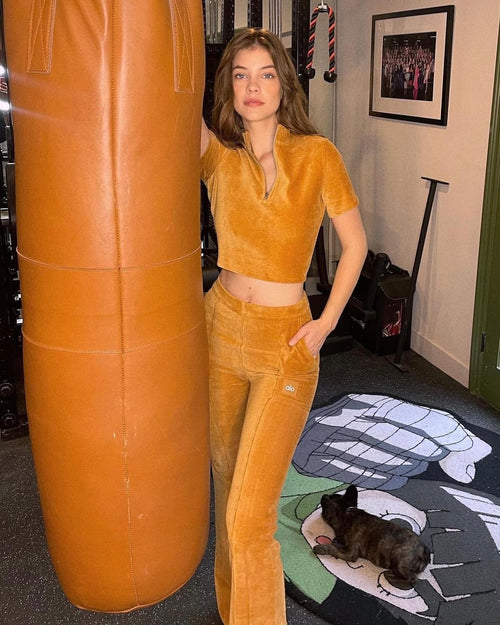One of the first things you learn from taking a yoga class from Hiro Landazuri is how well the yogi knows his stuff. Instead of rattling off fast-paced sequences, he breaks down poses, gives detailed alignment cues and makes hands-on adjustments—a uniquely technical approach to teaching that comes from his background in medicine. Hiro left the field he left after realizing it wasn't the right path for him, but his acute understanding of the body continues to serve him (and his students) well, and his desire to share that knowledge is inspiring. We recently caught up with him to find out what drew him to yoga, what it means to have a healthy practice and how he's learning to love himself through every life transition.
You were in the medical field before you started teaching yoga! What exactly did you do?
I was in a Cardiopulmonary Perfusion (open-heart bypass surgery) and Medical Pharmacology program and worked in heart transplant surgery. In Cardiopulmonary Perfusion, we had to completely stop the heart in order to operate on it. Tubes would be placed in the arteries and veins leading to and away from the heart and pumped into a machine that operates as an external heart. I would act as the temporary heart while the patient was undergoing surgery. For the transplant surgery, a surgeon and I would fly somewhere in the country to retrieve a heart and give it to someone on the transplant list. We would also do this with kidneys.
[caption id="attachment_3970" align="alignnone" width="1196"] Regenerate Short[/caption]
Regenerate Short[/caption]
When and how did you get into yoga?
I got into yoga 16 years ago. I was really into running at the time, and my dad suggested that yoga would help with my plantar fasciitis (inflammation of the ligament in the heel), and it did. I fell in love with how challenging yoga was. Over time I fell in love with other aspects of it, like how well it mitigated stress, and I started creating a more positive life for myself mentally.
What made you decide to take the leap from practicing to teaching?
I started teaching in 2007 at the beginning of the financial crisis here in the U.S. I applied to jobs everywhere, thinking I would be able to find a job since I had an organic chemistry publication under my belt (I wrote a lab textbook for my university), but when I couldn’t even get a job as a bus boy or barista, the manager at the university gym offered me a job to teach yoga there. I took it and started teaching privates as well. I think if it wasn’t out of necessity, I would have been too afraid to take the leap into teaching.
[caption id="attachment_3960" align="alignnone" width="2184"] Technical Moto Jogger[/caption]
Technical Moto Jogger[/caption]
How has practicing yoga affected your day-to-day life?
For maybe the first decade, the practice really helped me ground down and find a better mental state. In more recent years, I realized how much I used the physical practice as, I call it, aspirin for the habits that were perpetuating problems in my personal life. So, I’ve been embodying more of yoga's philosophy and practicing compassion, presence and mindfulness with the intention of truly applying it to my life off the mat, instead of just practicing to feel better.
How does your background in science and profound knowledge of anatomy inform the way you teach?
I think the most valuable tool is being able to recognize that general cues of alignment do not work for everyone, especially when injuries are involved. Having a strong understanding of how the body works on a detailed level, causes and effects of various injuries and how the body will compensate around injuries over time when left unaddressed has has helped me pinpoint with a student on a one-to-one level what is working or not working to further their practice both physically and mentally.
[caption id="attachment_3968" align="alignnone" width="1194"] Triumph Short[/caption]
Triumph Short[/caption]
Top tips for a safe and effective practice?
As much as the practice is physical, it's very much a practice around the nervous system, so it's important to learn how to get in touch with the body's responses on the mat, calm the nervous system and then apply that practice off the mat. Understanding the muscles will also tell you how the bones are positioned and how they move in poses, so, when looking at how to deepen a pose or find better alignment, think about what muscles are moving your bones into position, and you’ll kill two birds with one stone.
Understanding that real change never comes easy nor does it feel comfortable is also important. Learning the difference between pushing for growth from a place of ego versus seeing growing as an exploration of the self through compassion and self-wonder really helped me use yoga to grow in all aspects of my life.
[caption id="attachment_3959" align="alignnone" width="1456"] Technical Moto Jogger[/caption]
Technical Moto Jogger[/caption]
You’ve opened up about your relationship with fear on your Instagram—fear of what leaving medicine would say about you, fear of not working hard enough, etc. How do you work through these fears?
The first step was getting in touch with my truth—who I am, what really matters to me, what I want in life and why. Then looking at my core beliefs, uncovering my subconscious beliefs and seeing how consistent or inconsistent they were with my truths. A good example of this is a lot of us, myself especially, say we want to experience love, yet we are more invested in not experiencing hurt, loss and rejection than we are with being in a state that would allow us to experience love.
"Learning the difference between pushing for growth from a place of ego versus growing as an exploration of self through compassion and self-wonder really helped me use yoga to grow in all aspects of my life."
Also, a key thing to realize is our brains are biologically wired to keep us out of danger. Our initial assessment of a situation isn’t whether its good or bad, it's whether it’s safe or unsafe for us. As you work on changing habits, or making any change at all, even if it's positive, understand that this threatens our current state of mind. Our mind will consistently try to find ways to resist change until, through continual practice, it sees the positive change as safe. Basically, showing up for every moment without ego and not thinking, I have it all figured out, is helping me work through fear and not act out of fear.
[caption id="attachment_3969" align="alignnone" width="1196"] Technical Moto Jogger[/caption]
Technical Moto Jogger[/caption]
What’s something people might be surprised to learn about you?
I lived with severe anxiety for most of my life, so doing things in public, being around people and even teaching yoga or posting about myself on social media used to terrify me. When I stopped living in the story that that’s who I am and started telling myself a different story of self-confidence, self-efficacy and owning who I am, everything changed. Sometimes I still get nervous teaching or speaking into a camera, but understanding that reality is just the stories we tell ourselves has helped me live a much healthier life.
What advice do you have for people just getting started with yoga?
Yoga is a beautiful practice that can bring so much self-empowerment. Stay focused on learning more about yourself instead of how your poses look. The more you practice, the more you can draw parallels on and off the mat, learn who you are, how to love who you are and how to become the version of yourself that you want to be.
Get the vibes going with Hiro's go-to songs for practice and follow his journey on Instagram!



